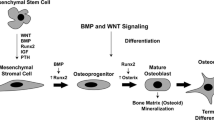Abstract.
Over the past decade there have been major advances in our understanding of the factors that regulate osteoclast formation and activity. It is now apparent that receptor activator NFκB (RANK), its ligand, RANKL (also known as TRANCE, osteoclast differentiation factor and osteoprotegerin (OPG) ligand) and the natural RANKL inhibitor, OPG, are the key factors regulating osteoclast formation in normal bone physiology. The molecular interactions of these molecules regulate osteoclast formation and subsequent bone loss in disease and there is now strong evidence that the bone loss associated with inflammatory diseases, such as rheumatoid arthritis, periodontal disease and peri-implant loosening, is regulated by the action of RANK, RANKL, and OPG. These molecules are targets for the pharmacological regulation of severe bone loss in several common inflammatory diseases.
Similar content being viewed by others
Author information
Authors and Affiliations
Corresponding author
Additional information
Received 8 April 2004; accepted by R. Pettipher 24 June 2004
An erratum to this article is available at http://dx.doi.org/10.1007/s00011-011-0369-7.
Rights and permissions
About this article
Cite this article
Haynes, D.R. Bone lysis and inflammation. Inflamm. res. 53, 596–600 (2004). https://doi.org/10.1007/s00011-004-1303-z
Issue Date:
DOI: https://doi.org/10.1007/s00011-004-1303-z




